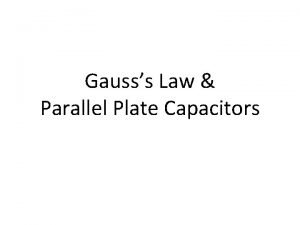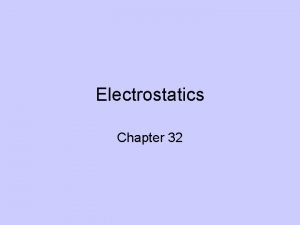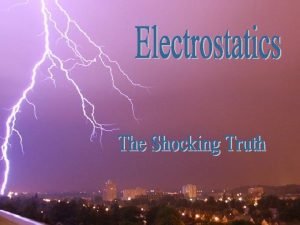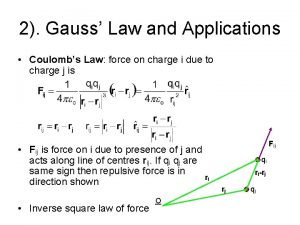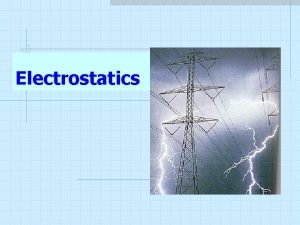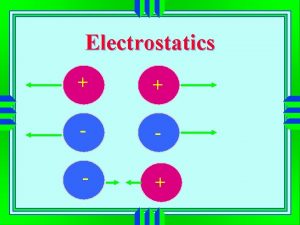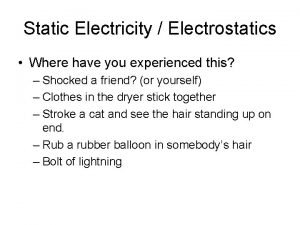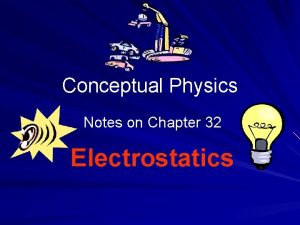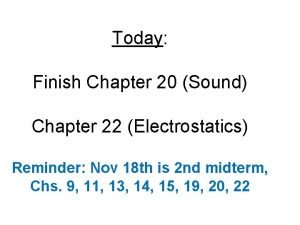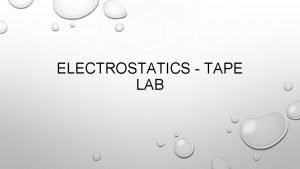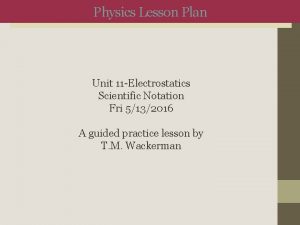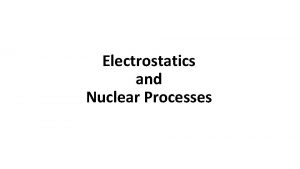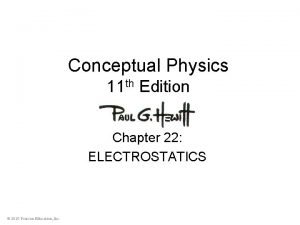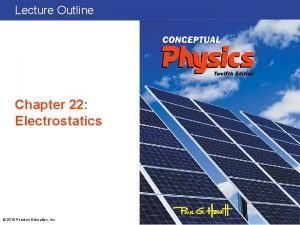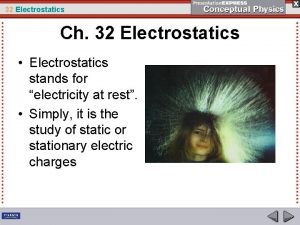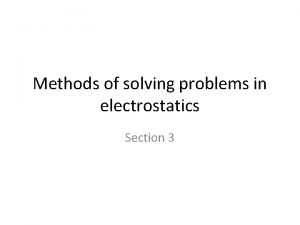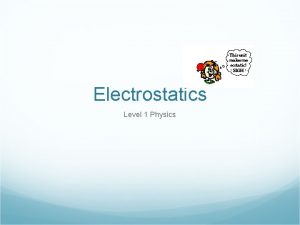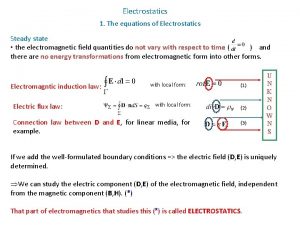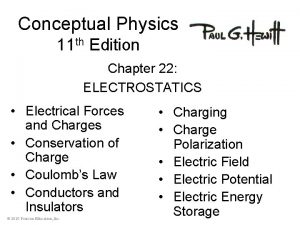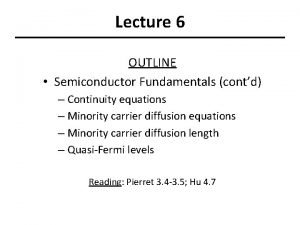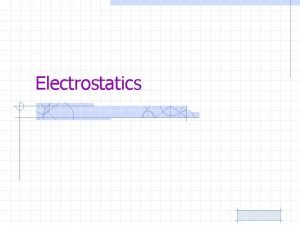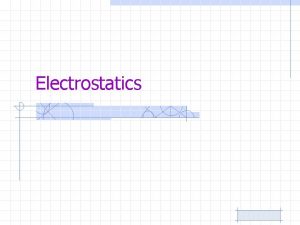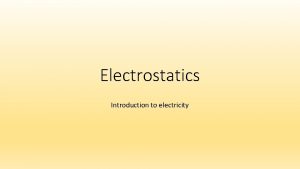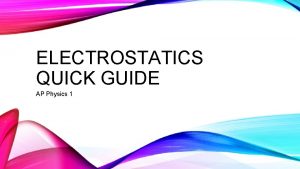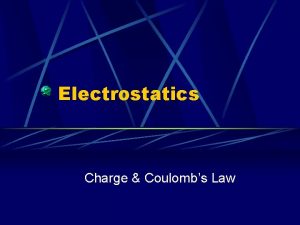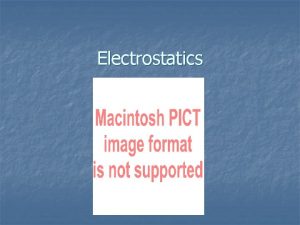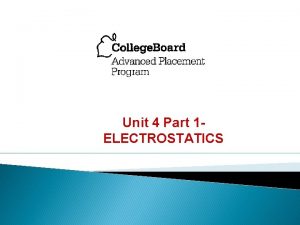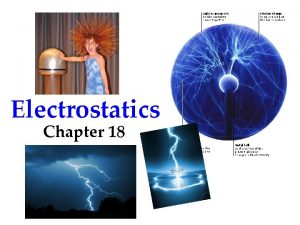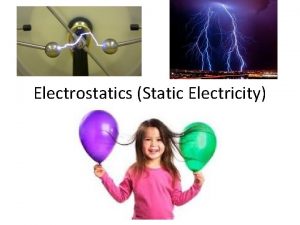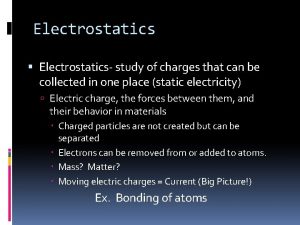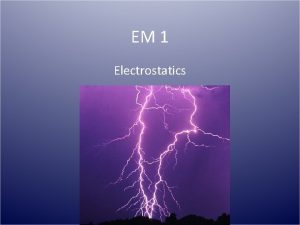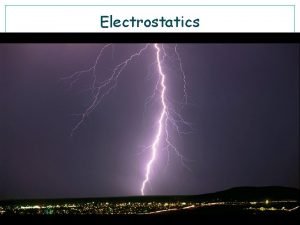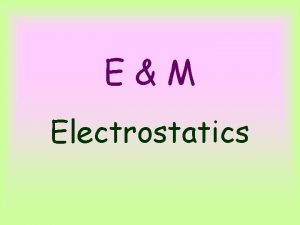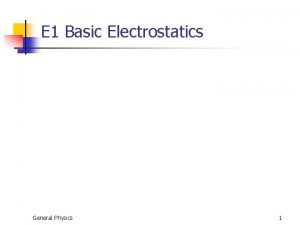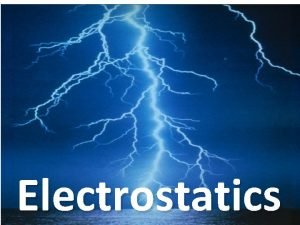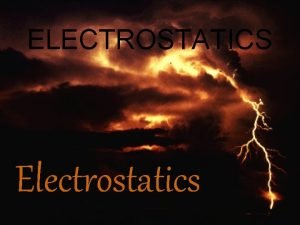Electrostatics Electrostatics Electrostatics is the study of i






















- Slides: 22

Electrostatics

Electrostatics • Electrostatics is the study of ; i. e. , charged objects that are stationary or in a fixed position.

Charged and Uncharged Objects • Neutral Object: An object that has. • # of = • Charged Object: An object with an ` or of electrons. + - + +

Elementary Charge (e) • What is the charge of an electron? • • ) What is the charge of a proton? • • ( ( ) The magnitude of the charge of the is equal and opposite that of the. • Note: In physics, the charge of an electron is NOT or !

Example #1 • An object has three excess electrons. – What is its “fundamental charge”? - – What is its charge in coulombs? Note: - “ charge” = charge - “ ” is the variable letter used for

Example #2 • An object has 75 protons and 65 electrons – What is its “fundamental charge”? – What is its charge in coulombs? Note: You the of e or have fractions of charge, e. g.

Law of Conservation of Charge • The total amount of charge in a closed system remains – charge is not or , it only moves from one object to another • Charge “moves” as a result of ONLY!!! movement

Rubber and Wool/Glass and Silk • Rubbing a with a piece of : The will pull the electrons off the wool, so that the rubber rod will end up with a net charge and the will have a net charge. • Rubbing a with a piece of : The will pull the electrons off the , so that the rod will end up with a net charge and the will have a net charge.

Conductors and Insulators • Conductors: Materials that allow for the of electrons. – The best conductors come from the periodic table. – The characteristics of the because at least held tightly by the nucleus. • Insulators: Materials that do to . of electron is not allow electrons

Forces of Attraction and Repulsion • In nature there are three principle forces – , (strong & weak). and – Electromagnetic: • Attractive Forces: charges attract one another. A charged object will be attracted to a charged object and vice versa. • Repulsive Forces: charges repel. Two charged objects or two charged objects in proximity to one another will experience a repulsive force.

How do Objects Become Charged? • • • : Through direct contact. : Separation of Charge. : Without direct contact.

Charge by Conduction • Electrons flow from a charged object to an uncharged object through .

Charge • Conductors: will the space between them, which means that they will reside on the surface of the object with a distribution. • Insulators: will be located largely where they were transferred to the material.

Charge Distribution • One of these isolated charged spheres is copper and the other is rubber. The diagram below depicts the distribution of - charge over the surface of two spheres. Which one is rubber and which one is copper?

Example #3 • Two charge spheres are brought into contact with one another and then separated. One of the spheres has a charge of -5 C while the other has a charge of +8 C prior to them being brought into contact with one another. – What is the total charge of the system? – What is the charge on each of the spheres afterwards? – How many elementary charges would have to be added or subtracted from each sphere to make them neutral? + + + + + _ _ _ + _ _ _ _


Example 3, cont. : • There are two ways of finding the number of elementary charges that would have to be added or subtracted from each sphere. • or

of Charge • When two neutral bodies are rubbed together, they can become charged through – As per become will become – Electrons will be . , one body will charged while the other body charged. from one object and on the other. • When a charged body is brought in close proximity to one that is neutral, the neutral one will develop an in charge distribution. + - ❘ - - - - + + - - + -+

Separation of Charge and Lightning

Charge by • Electrons flow from one sphere to the other due to of charge.

Charge by Induction of an Electroscope

Types of Charge • Positively charged objects have a deficiency of electrons. • Negatively charged objects have a surplus of electrons. • Note that the type of charge is in reference to electrons and not protons. – Why? • Because electrons exist outside the positive nucleus and can be readily transferred from one object to another.
 Electrostatics
Electrostatics Chapter 32 electrostatics
Chapter 32 electrostatics Type of charging processes
Type of charging processes Coulomb's law integral form
Coulomb's law integral form Electrostatics is
Electrostatics is Electrostatics
Electrostatics First law of electrostatics
First law of electrostatics Facts about electrostatics
Facts about electrostatics Conceptual physics electrostatics
Conceptual physics electrostatics Chapter 22 electrostatics
Chapter 22 electrostatics Electrostatics sticky tape lab answers
Electrostatics sticky tape lab answers Electrostatics lesson plan
Electrostatics lesson plan Electrostatics formula
Electrostatics formula Physics classroom electrostatics
Physics classroom electrostatics Conceptual physics chapter 22: electrostatics answers
Conceptual physics chapter 22: electrostatics answers Chapter 22 electrostatics
Chapter 22 electrostatics Electrostatics
Electrostatics Method of inversion electrostatics
Method of inversion electrostatics Electric charge
Electric charge Electrostatics
Electrostatics Conceptual physics chapter 22 electrostatics
Conceptual physics chapter 22 electrostatics Continuity equation semiconductor
Continuity equation semiconductor Công thức tiính động năng
Công thức tiính động năng
